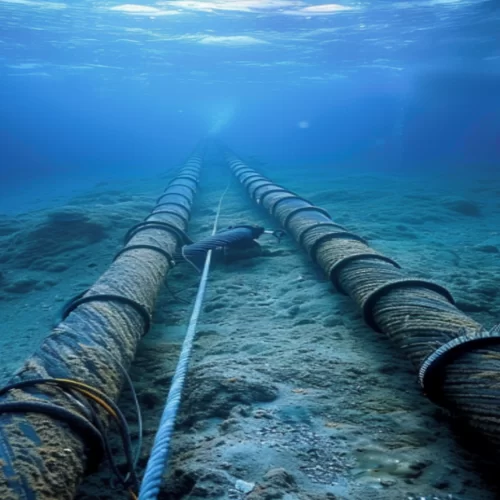Undersea cables serve as the backbone of global communication networks, facilitating over 99% of international data traffic, including financial transactions, internet access, and secure communications for governments and businesses. Despite their critical role, these cables are vulnerable to accidental damage, environmental factors, and intentional sabotage. Recent incidents in the Baltic Sea have underscored these vulnerabilities, raising alarms about the need to protect this vital infrastructure.
Recent Incidents in the Baltic Sea
Finland-Germany Cable Severance
In October 2024, a critical undersea fiber-optic cable connecting Finland to Germany was severed, causing significant communication disruptions. The damage occurred in international waters, making the investigation particularly challenging. Early reports suggested potential sabotage, with suspicions centering on a Chinese vessel detected near the incident site before the severance. This led to speculation about deliberate interference, though conclusive evidence remains elusive.
Lithuania-Sweden Cable Damage
Around the same time, a cable linking Lithuania to Sweden was also damaged. While initial assessments pointed to potential environmental factors, the proximity of Russian vessels near the damage site has heightened concerns about possible geopolitical motivations. The Lithuanian government has called for increased regional cooperation to secure undersea infrastructure.
Geopolitical Context and Implications
The Baltic Sea is a strategically sensitive region bordered by NATO allies and Russia. It serves as a critical conduit for energy supplies, communication networks, and military operations. The presence of Russian intelligence and naval vessels near the sites of cable damage has escalated tensions, particularly among NATO member states.
- NATO Concerns: The alliance has long identified undersea cables as a point of vulnerability in hybrid warfare scenarios. NATO countries have increased naval patrols and surveillance in the Baltic Sea, aiming to deter potential threats to their infrastructure.
- Russian Interests: Russia’s activities in the region, including the deployment of vessels capable of undersea operations, have raised suspicions of intentional sabotage as part of broader geopolitical maneuvering.
- China’s Involvement: The reported presence of a Chinese vessel near the Finland-Germany cable incident has introduced additional complexity, suggesting that other global powers may have strategic interests in the Baltic Sea.
Challenges in Attribution
One of the greatest difficulties in responding to undersea cable damage is determining the cause. Accidental damage from fishing activities or anchors is common, but deliberate sabotage is harder to identify and prove. Investigations often involve:
- Limited Evidence: The underwater environment makes it challenging to gather physical evidence.
- Ambiguity: Differentiating between accidental and intentional damage requires extensive analysis, often involving multiple nations.
- Geopolitical Risks: Accusations of sabotage without definitive proof can exacerbate international tensions.
Strategic Considerations for Securing Undersea Cables
Increased Surveillance and Monitoring
Investing in advanced technologies to monitor undersea cable networks is critical. Autonomous underwater drones and sensor networks could provide real-time alerts for disruptions or suspicious activities.
International Cooperation
The global nature of undersea cable networks necessitates collaboration among nations. Multilateral agreements focusing on the protection of critical infrastructure could enhance collective security. The Baltic Sea incidents have prompted discussions within NATO about creating a unified strategy for undersea cable protection.
Rapid Response Capabilities
Developing mechanisms to quickly assess and repair damage can mitigate the impact of disruptions. Specialized vessels and trained teams equipped to handle underwater repairs are essential for maintaining connectivity.
Resilience through Redundancy
Building redundant cable systems and diversifying routes can reduce the impact of damage to a single cable. Investments in satellite-based communication systems can also provide backup for critical data traffic.
Economic and Security Impacts
Undersea cable disruptions have far-reaching consequences, including:
- Economic Losses: Financial markets, which rely heavily on secure and instantaneous data transmission, are particularly vulnerable to communication outages.
- Military Risks: Secure communications for defense operations depend on undersea cables. Damage to these cables could impair operational readiness and coordination among allies.
- Public Infrastructure: Disruptions in internet and communication services can affect businesses, healthcare systems, and government operations.
Conclusion
The recent incidents in the Baltic Sea serve as a stark reminder of the vulnerabilities associated with undersea cables. As geopolitical tensions rise, the risk of intentional sabotage cannot be ignored. To secure these vital lifelines, governments and international organizations must prioritize surveillance, cooperation, and resilience strategies. The stakes are high, as undersea cables underpin not only global communication but also economic stability and national security. These efforts will be critical in ensuring the uninterrupted functioning of the digital economy and safeguarding against the evolving threats of hybrid warfare.





